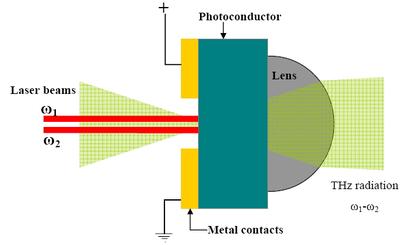THz Generation

Introduction
The band within the electromagnetic spectrum between about 300 GHz and 3 THz is often referred to as terahertz radiation. It is in between the frequency regions in which optical and microwave technologies work well and hence there are not a lot of good sources around. Terahertz radiation is considered to be an upcoming technology in material inspection, quality control, gas sensing, surveillance and security applications, and wireless, short-haul communication.
In a scientific realm, high-resolution THz sources are important for Terahertz spectroscopy, e.g. for astrochemically important molecules and local oscillators for THz telescopes.
Advancing power, tunability, compactness and affordability of Terahertz sources is a very active research area in academia as well at the industrial interface because progress in applications is currently hindered by a lack of suitable sources.
Experiment
One method to produce THz radiation is to mix two cw infrared lasers in a special kind of semiconductor (low-temperature grown GaAs), which generates their difference frequency that can be tuned into the THz range. Thermal failure was identified to be the limiting factor for THz power and the current investigations are directed on improving heat sinking and understanding temperature characteristics of antennas. We are working to overcome this using diamond heat sinking (see J. Appl. Phys. 2012).
Another area of research is the use of quantum dots for THz generation.
Coverage and Esteem
Coverage in Laser Focus World Jan. 2013
Publications
Ackemann et al. Diamond heat sinking of terahertz antennas for continuous-wave photomixing. J. Appl. Phys. 112, 123109 (2012).
People
- Prof Thorsten Ackemann
- Dr Helen Fraser
- Mr Scott Campbell
- Prof Erling Riis
- Dr Aidan Arnold
Collaborations
- Prof Mohamed Missous Microelectronics and Nanostructure Group, School of Electrical and Electronic Engineering, University of Manchester
- Dr Guillaume Huyet Cork Institute of Technology, Tyndall National Institute
- Dr Maria Anna Cataluna University of Dundee
Previous group members
- Mrs Stefanie Keatings
- Mr Pradeep Luke Sam
Funding
- T. Ackemann Lifetime measurements 07/2011 – 12/2011 Strathclyde Links (KE funding)
- T. Ackemann, H. Fraser High power Terahertz generation enabled by improved heat sinking 05/2010 - 07/2011 The Royal Society London
- T. Ackemann Characterization of cw THz emitters 07/2010 – 06/2011 SUPA Start (KE funding)
- T. Ackemann, H. Fraser, E. Riis High-power cw Terahertz radiation by photomixing 06/2008 – 04/2009 Research and Development Fund, University of Strathclyde